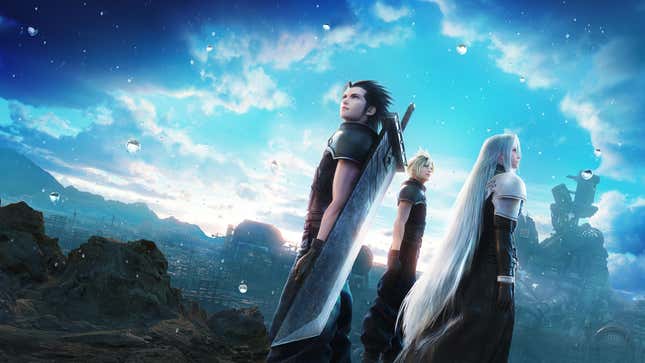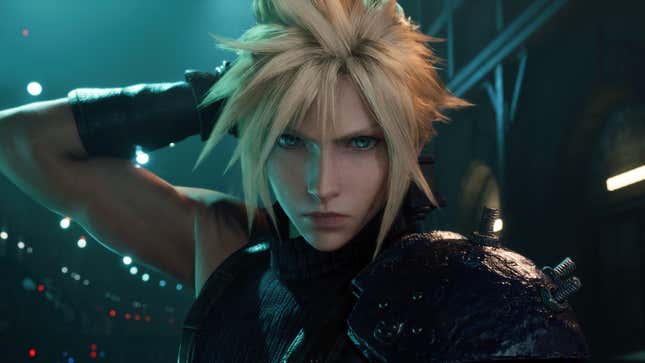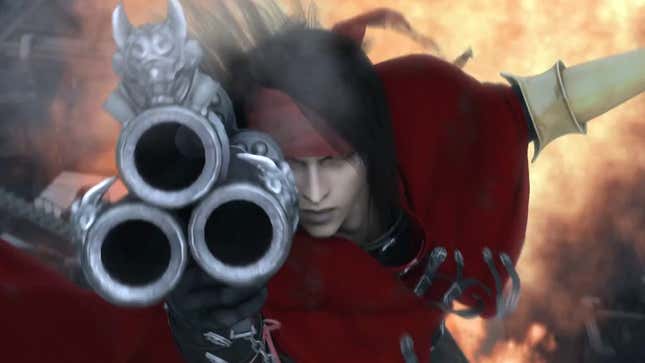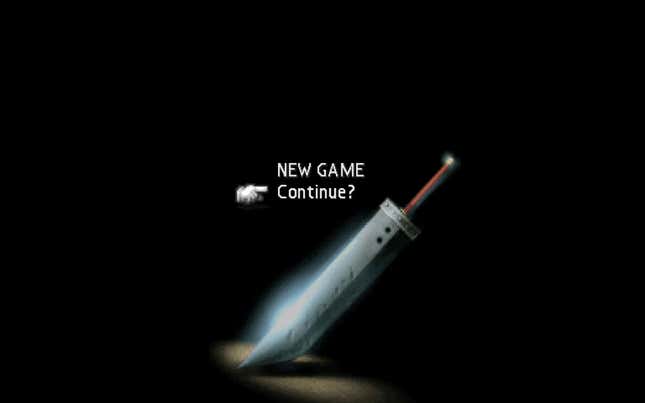Final Fantasy VII Rebirth is out on February 29, 2024. But if you haven’t played 2020’s Remake, or any of the other games in the FF7 universe (known officially as the Compilation of Final Fantasy VII), you might be wondering where to start, what order you should play the games in, and whether or not you should play the original first.
This guide will break down the games, films, and more that make up the FFVII universe, with suggestions on where to start if you’re new to Cloud and co.’s epic journey—or just a bit rusty on the details. This guide is also free of spoilers, so feel free to read on.
Final Fantasy VII: It all started in 1997
First released on the original PlayStation back in 1997, Final Fantasy VII became one of the most essential RPG experiences of the era—and one of the most influential games of all time. The story follows Cloud Strife, a former soldier turned mercenary hired by the eco-terrorist group Avalanche to put an end to the Shinra Electric Power Company’s destruction of the planet. That premise unfolds into a world-spanning adventure with tense interpersonal relationships and more than a couple of mind-bending twists and turns.
You can play the original FF7 on virtually all modern consoles. A touched-up remaster of the original (which still features pre-rendered backgrounds and blocky characters) is available on PS5, PS4, Xbox One, Xbox Series X/S, Switch, and Windows. This version features an improved translation over the sloppy original which contained classic lines such as “this guy are sick.”
But the remake doesn’t make the original FF7 obsolete. Final Fantasy VII Remake takes plenty of narrative liberties and toys with the expectations of those who played the original. So if you go back to play the 1997 classic, the remake will still deliver a sense of suspense and uncertainty. We expect that to be the case of Rebirth as well.

Final Fantasy VII comes with PlayStation Plus Extra
If you’re a PS Plus subscriber at the Extra tier, you can download and start playing Final Fantasy VII on PS5 right now.
You can get through the main story of FF7 at just under 40 hours, according to HowLongToBeat.com, but there’s easily 80+ hours of side diversions and mini-games to discover. As a strictly turn-based game with old-school blocky polygons, Final Fantasy VII certainly feels of its era, but it’s well worth playing either before or after Remake or Rebirth.

Crises and Dirges: Final Fantasy VII’s prequels and sequels
In the early 2000’s, Square Enix started expanding the world of FF7 with some spinoffs. The developer kicked things off with Before Crisis: Final Fantasy VII, a mobile game. This one’s difficult to get hold of as it was made for early 2000s cell phones and isn’t available on any modern devices.
Before Crisis takes place before the events of FF7. Its story content has reappeared in the modern mobile phone game Final Fantasy VII: Ever Crisis. That said, Ever Crisis is filled with aggressive microtransactions and lootboxes, making for an abrasive experience. It’s not an ideal way to experience any of the elements of Final Fantasy VII’s story. We recommend watching a Lets Play or reading a synopsis to catch up on what happens in Before Crisis.
After Before Crisis, the next video game in the series would be a third-person shooter for the PlayStation 2 set after the events of Final Fantasy VII (and after the events of the film Advent Children, more on that in a moment). Dirge of Cerberus stars the gun-wielding Vincent Valentine, an optional character in the original 1997 game. As of the time of this writing, the original PS2 copy is the only way to play Dirge of Cerberus, which runs at an estimated 12 hours of gameplay for the main story.
Following Dirge of Cerberus, Square Enix released Crisis Core: Final Fantasy VII on the PSP, taking place in-between Before Crisis and the original main game. Though it introduces a number of extra characters and questionable twists and turns to an already dense story, it’s thoroughly fun and engaging as an RPG.
Read More: Crisis Core – Final Fantasy VII – Reunion: The Kotaku Review
A remaster of Crisis Core is available on PS5, PS4, Xbox One, Xbox Series X/S, Switch, and Windows as Crisis Core – Final Fantasy VII – Reunion. The main story of Crisis Core will run about 14 hours, with close to 50 hours of gameplay if you’re going for a completionist run.

Remakes and rebirths: the modern FFVII trilogy
At E3 2015, following years of hope for a remake (arguably inspired by a PS3 tech demo that showed off a reimagined intro to Final Fantasy VII), Square Enix announced that an official remake of 1997’s Final Fantasy VII was in development.
The game arrived as Final Fantasy VII Remake on April 10, 2020, a complete reimagining of FFVII’s opening “Midgar” sections. Though the remake takes the story in some new and unexpected directions, it remains a faithful and expansive retelling of FFVII’s opening moments, setting the stage for two more games that promise equal amounts of nostalgia and tantalizing new story developments.
Final Fantasy VII Remake received a DLC chapter with Episode Intermission in 2021, which takes place alongside the events of Remake and stars one of the original game’s optional characters, Yuffie Kisaragi.
In 2022, Square Enix revealed that FFVII’s remake project would span a trilogy, with the second installment, Final Fantasy VII Rebirth on the way. The third game is yet unnamed.
Read More: Everything We Know About Final Fantasy VII Rebirth
Rebirth takes place right after Remake leaves off and is set to feature much larger environments than the 2020 remake. Like Remake, Rebirth will expand and change up some of the events of the original game. How much liberty it will take remains to be seen. You can read up on everything we know about Final Fantasy VII Rebirth here.

Advent Children and Last Order: Final Fantasy VII’s films
In 2005, Final Fantasy VII got two film treatments, one with a CG sequel to the game’s main story, Final Fantasy VII: Advent Children, and a 25-minute anime retelling some of the events leading up to Final Fantasy VII.
While Advent Children features some excellent visuals and more than a few thrilling fight scenes, it hasn’t been universally accepted by fans of the original 1997 game. With a convoluted plot that makes for a tough watch for those unfamiliar with all of the characters and plot turns of Final Fantasy VII, it stands at a 50% rating on Rotten Tomatoes.
Last Order, on the other hand, enjoyed a warmer reception. As this anime is a retelling of already solid story material from the original game, it doesn’t have the burden of proving itself through a new story and instead adapts a proven narrative.
Hey, there are short stories and a novel too!
If you’re all-in on the Final Fantasy VII universe, there’s some fiction to read up on as well. Final Fantasy VII: On the Way to a Smile is a collection of short stories that chronicles the lives of various characters after the events of the original 1997 game. These stories take place before Advent Children. Final Fantasy VII: The Kids Are Alright: A Turks Side Story is another tale leading up to the events of Advent Children.
Finally, Final Fantasy VII Remake: Traces of Two Pasts is a novel focused on characters Aerith and Tifa, diving deep into their backstories.

Final Fantasy VII: Where to start?
If you’ve never played any of the Final Fantasy VII games before and are up for a lovely retro throwback, we heartily recommend playing the original FF7 first. It’s readily available on all main gaming platforms and it is easily one of the greatest video games ever made.
For something a bit more modern, Final Fantasy VII Remake isn’t a bad place to start either, followed by Episode: Intermission. From there, you’ll be set to dive straight into Rebirth when it launches in late February.
If you’re starting with the remakes, it’s advisable to hold off on Crisis Core until you play Rebirth or the original Final Fantasy VII. The events of the prequel are discussed in FFVII (and are expected to be a focus of Rebirth), so you’ll get a sense of what happens in Crisis Core and who the characters are. Crisis Core’s story is best told with the surface-level details of what happens to Cloud and side character Zack Fair in FF& in mind; it works best as an embellished flashback. You can also hunt down a copy of Last Order for a retelling of the events that set much of what happens in Final Fantasy VII into motion.
While the expanded universe can afford you more time spent with this series’ wonderful cast of characters, virtually everything outside of FF7 and Remake are much more niche offerings. So don’t let all the stuff out there deter you!
Credit : Source Post

